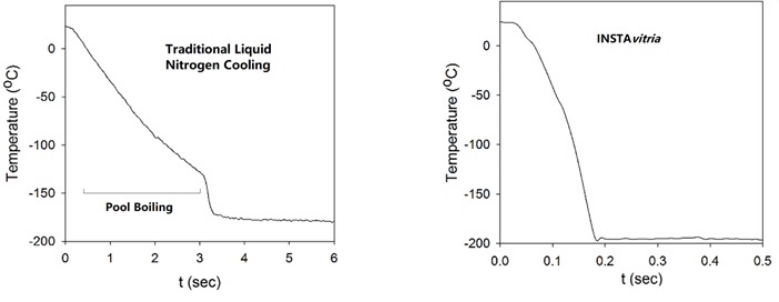InstaVitria® Ultra-fast Cooling System
“InstaVitria’’ stands for an “Instant Vitrification’’ system
The invention of “InstaVitria®” technology (International Patent Filing) deploys an advanced thermal fluidic design that achieves over 106 K/min cooling rate for the cells located on the surface of thin tissue. This ultra-fast cooling rate is two order of magnitude higher than rates achieved by traditional approaches for such tissues wherein tissues are plunged directly into liquid nitrogen. The ultra-fast cooling rate for InstaVitria® enables direct vitrification (solidification without ice formation) of cells and achieves efficient cryopreservation without the use of any cell permeating cryoprotectant. In some applications, it potentially realizes the ideal “in-situ” cryopreservation procedure, i.e. cryopreserving cells or tissues in their normal culture or holding media. The technology is still under R&D. Once fully developed, the method can give birth to a new generation of cryopreservation technologies for cells and tissues, especially those created by further incorporation of bioengineering or bioartificial technologies.
Instead of the use of traditional applications that utilize extremely high pressure to quench liquid nitrogen evaporation, the InstaVitria® invention deploys a strategy whereby an array of liquid nitrogen jet flows and cold gas nitrogen jet flows possessing a balanced distribution provides a non-evaporating and low-pressure liquid nitrogen flow impinging onto a sample surface. The design of the flow array or matrix also achieves uniform cooling on the surface of a typical bioengineered tissue (typically less than 5 cm in diameter or size) or biological tissues (e.g., corneal tissues that are approximately 2 cm in diameter). The device can be upscaled to cool much larger samples, e.g. thin skin grafts of an approximately 10 cm × 10 cm area (see Applications for details). The system requires only a tank of liquid nitrogen that can be ordered from commercial providers to provide a liquid nitrogen source. The InstaVitria® system also achieves significantly improved viability in comparison to results obtained by directly plunging samples into liquid nitrogen, especially for samples comprising relatively large lipid rich cells, e.g. intact pig embryos. Pig embryos are critical for both xeno bioengineering technologies and agricultural applications; however, they are highly challenging to cryopreserve through traditional approaches, in part due to the fragility of complicated ultra-structures inside cells; namely, the intracellular lipid vesicles. The ultra-fast cooling rate achieved by using InstaVitria® significantly promotes the recovery of those ultra-structures after thawing (see APPLICATIONS for details).
For tissues, the InstaVitria® system includes a novel disposable sample holder that protects the cell layers and prevents direct contact between tissue cells and impinging liquid nitrogen jets. The holder is hermetically sealed after the sample is loaded. These two design features prevent potential sample contamination during cooling and storage. A warming subsystem using water jets to increase warming rate and to improve warming rate uniformity is also an integral part of the InstaVitria® system. To improve safety during operation while using liquid nitrogen jets as the cooling fluid, a venting subsystem is included to prevent accumulation of the released nitrogen gas into the operation site.

A comparison between the temperature profiles of a 0.2 mm thermal couple (simulating a typical pig embryo of that size, as one of the smallest thermal couples in the market) that when cooled by traditional liquid nitrogen cooling approach (i.e., by directly plunging it directly into liquid nitrogen) and when cooled by InstaVitria® technology. The unique flow dynamics produced by InstaVitria® successfully remove the “pool boiling” region that is typically present in normal liquid nitrogen cooling: the pool boiling process tremendously lowered the cooling rate due to the thermal insulation generated by large amount of bubble formation due to fast evaporation of liquid nitrogen, that is successfully prevented or minimized in InstaVitria® technology. For tissues with one or several layers of cells on the tissue surface—assuming the cell size is 10-20 µm (1/10th diameter of this particular thermal couple) - the cooling rate on those cell layers achieved by InstaVitria® should approach 106 K/min, though it is technically difficult to measure the ultra-fast cooling rates due to the limitation in the size of the thermal couple.
